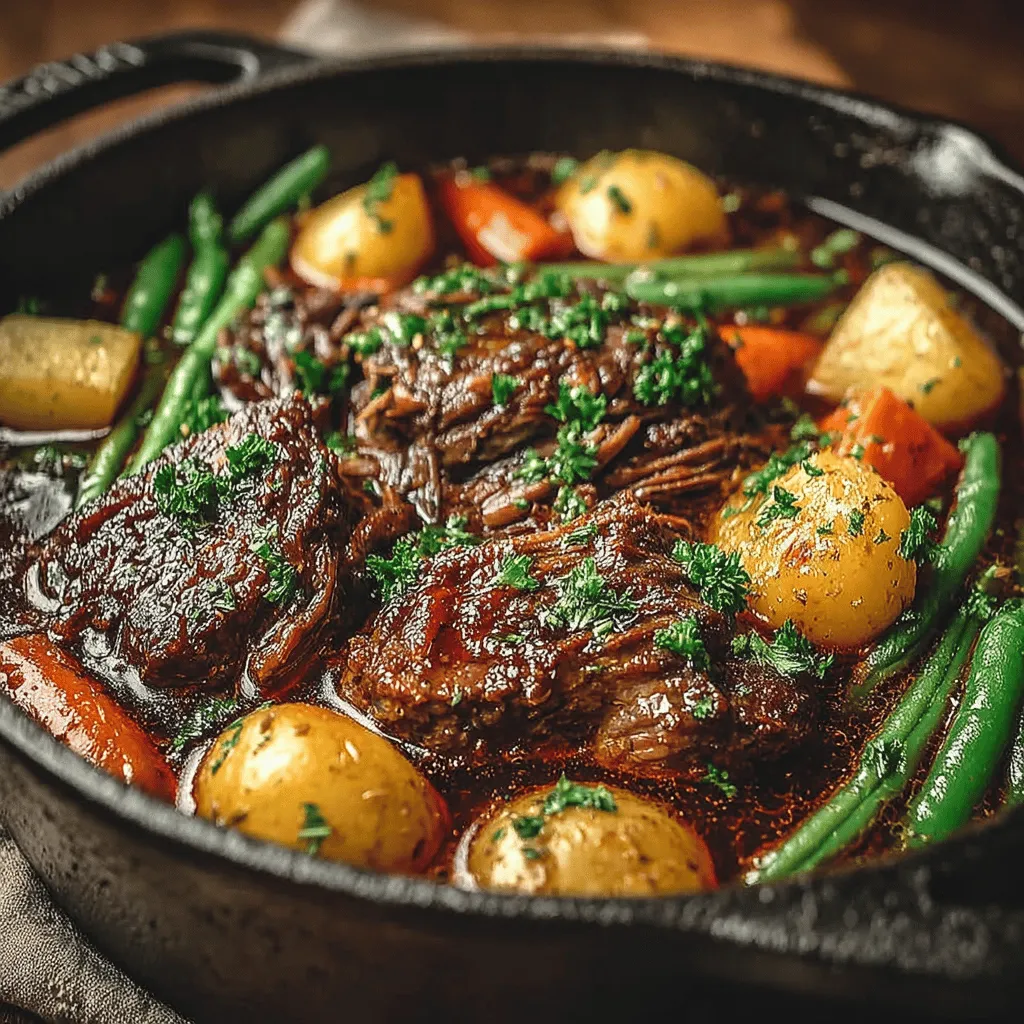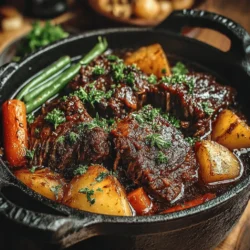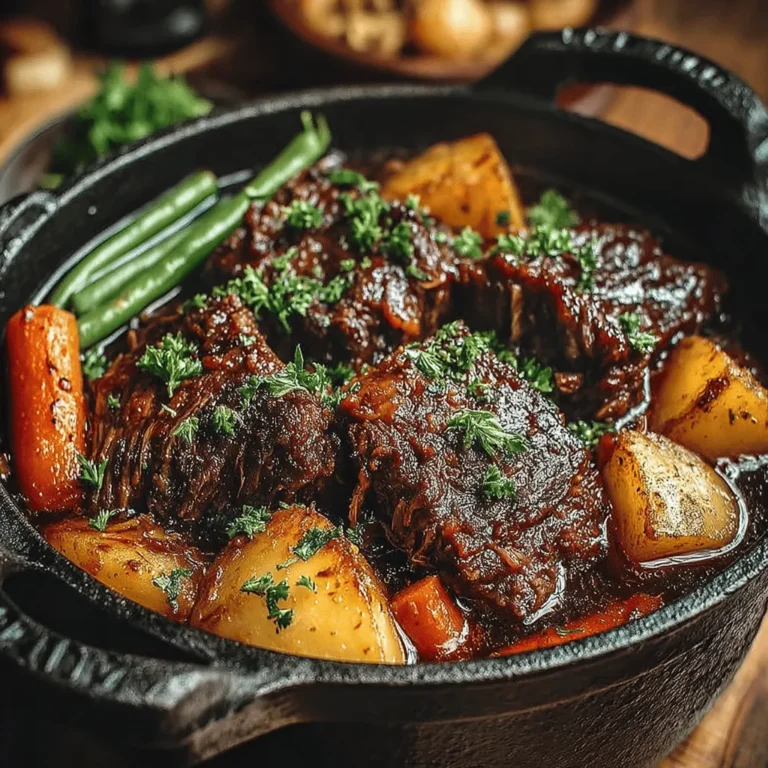Comforting Hearty Beef & Vegetable Pot Roast
Introduction
There’s something undeniably soothing about comfort food. It has the remarkable ability to evoke feelings of warmth and nostalgia, transporting us back to cherished moments spent around the dinner table with loved ones. Among the many dishes that fall under this category, pot roast stands out as a quintessential family favorite. Its rich, savory flavors and tender textures have made it a staple in homes across generations, bringing people together for hearty meals and meaningful conversations.
What makes pot roast so appealing? For one, it boasts a combination of hearty ingredients that create a satisfying and balanced meal. From succulent beef to vibrant vegetables, pot roast is a culinary embrace that nourishes both the body and the soul. Additionally, its ease of preparation allows even novice cooks to create a dish that feels both comforting and impressive. With minimal effort, you can prepare a meal that fills the kitchen with enticing aromas and invites everyone to the table.
The Joy of Cooking a Pot Roast
The tradition of cooking pot roast can be traced back to the 19th century, where it became a beloved dish in American homes. Often associated with Sunday dinners, pot roast symbolizes the gathering of family and friends around a warm meal, making it an integral part of many cultural cooking practices. Over the years, this dish has evolved, yet its core essence remains the same: a hearty, flavorful feast that brings people together.
One of the remarkable aspects of pot roast is its versatility. While the traditional recipe often features a beef chuck roast, it can easily be adapted to suit various dietary preferences. For instance, you can substitute beef with lamb, pork, or even mushrooms for a vegetarian option. Additionally, the choice of vegetables can be modified based on what’s in season or what you have on hand, making pot roast a flexible dish that can cater to different tastes and dietary needs.
Beyond the ingredients, the emotional connections that many people have with pot roast are profound. For countless families, preparing and sharing a pot roast signifies love, care, and togetherness. It’s a dish often served during special occasions and family gatherings, creating lasting memories that are intertwined with the flavors and aromas of the meal itself.
Key Ingredients and Their Benefits
To create the perfect comforting beef and vegetable pot roast, it’s essential to understand the key ingredients that contribute to its rich flavors and nourishing qualities.
– Beef Chuck Roast: This cut of beef is renowned for its marbling and flavor, making it ideal for slow cooking. When cooked low and slow, the connective tissues break down, resulting in a tender, juicy roast that practically melts in your mouth. The robust flavor of beef chuck roast becomes even more pronounced as it mingles with the accompanying vegetables and broth.
– Olive Oil: A staple in many kitchens, olive oil is not only a healthy fat but also enhances the overall flavor of the dish. Rich in monounsaturated fats and antioxidants, olive oil is a heart-healthy choice that complements the richness of the meat. It’s used to sear the beef, locking in the juices and creating a delicious crust.
– Aromatics (Onion and Garlic): These two ingredients are foundational in building the flavor profile of any savory dish. Onions add a natural sweetness when caramelized, while garlic provides a depth of flavor that elevates the pot roast to new heights. Together, they create a fragrant base that enhances the overall taste of the meal.
– Vegetables (Carrots, Potatoes, Green Beans): A true pot roast wouldn’t be complete without a medley of vegetables. Carrots add a natural sweetness and vibrant color, while potatoes absorb the rich flavors of the broth, creating a satisfying side. Green beans offer a fresh crunch that balances the dish, making it both nutritious and visually appealing.
– Beef Broth and Red Wine: These ingredients are key to achieving a rich, velvety sauce. Beef broth provides a deep umami flavor, while red wine adds acidity and complexity. Together, they form a luscious gravy that envelops the meat and vegetables, creating a harmonious blend of flavors.
– Herbs and Seasonings (Thyme, Rosemary, Bay Leaf): The aromatic qualities of herbs like thyme and rosemary are essential for infusing the pot roast with fragrance and depth. These herbs not only enhance the taste but also contribute to the comfort food experience, as their scents evoke warmth and home. Bay leaves add a subtle earthiness that rounds out the flavor profile, making each bite a delightful experience.
Step-by-Step Guide to Preparing the Perfect Pot Roast
Preparation Phase
Before diving into cooking, it’s crucial to prepare your ingredients properly. Start by choosing a quality beef chuck roast, ideally around 3 to 4 pounds, as this size will yield a tender and flavorful result. Take the time to season the meat generously with salt and pepper. This step is vital for enhancing the flavor; it forms a delicious crust during the cooking process. Allow the seasoned roast to rest for about 30 minutes at room temperature to ensure even cooking.
Searing the Meat
Once the roast is seasoned, it’s time to sear it—a technique that plays a pivotal role in flavor development. Heat a heavy-bottomed pot or Dutch oven over medium-high heat and add a few tablespoons of olive oil. When the oil is hot and shimmering, carefully place the roast in the pot. Allow it to sear without moving it for about 4-5 minutes until it develops a rich brown crust. This process not only locks in the juices but also adds depth to the overall flavor of the pot roast. After achieving a golden-brown exterior, flip the meat and repeat the process on the other side.
Once seared, remove the roast from the pot and set it aside. In the same pot, add chopped onions and minced garlic, scraping up any browned bits from the bottom—this is where much of the flavor resides. Sauté the aromatics until they become translucent and fragrant, which should take about 3-4 minutes. Afterward, deglaze the pot with a splash of red wine, allowing it to simmer and reduce for a minute or two before proceeding to the next steps.
Stay tuned for the continuation of this recipe, where we’ll explore the remaining steps to create a mouthwatering beef and vegetable pot roast that will surely become a beloved dish in your home.

Sautéing Aromatics
To start off our pot roast, we need to build a solid flavor foundation. This begins with sautéing aromatics like onions and garlic. When you heat a tablespoon of oil in your Dutch oven or heavy-bottomed pot over medium heat, add a finely chopped onion and sauté it until it becomes translucent, about 5 minutes. The sweet, caramelized notes from the onions will deepen the overall flavor of the dish.
Next, add minced garlic and sauté for an additional minute. Garlic not only adds depth but also provides an aromatic quality that elevates the dish. Ensure that the garlic doesn’t brown too much, as burnt garlic can introduce bitterness. Together, these ingredients create a fragrant base that will enhance the overall taste of your pot roast.
Deglazing the Pot
Once the aromatics are perfectly sautéed, it’s time to deglaze the pot. Deglazing is the process of adding a liquid to the hot pot to loosen the flavorful bits stuck to the bottom, known as fond. This is crucial, as these browned bits contain concentrated flavors that contribute significantly to the overall depth of the sauce.
Pour in a cup of red wine (such as Cabernet Sauvignon or Merlot) and use a wooden spoon to scrape the bottom of the pot. Allow the wine to simmer for a few minutes until it reduces by half. The acidity of the wine will help to lift those flavors while adding its own complex notes, making your dish even heartier and more robust.
Building the Flavor Base
With the fond released from the pot, it’s time to build the sauce that will envelop your pot roast. Add 4 cups of beef broth, along with 2 tablespoons of tomato paste, into the pot. The broth provides a savory base, while the tomato paste introduces a hint of sweetness and acidity that balances the richness of the beef.
Stir everything together and bring the mixture to a gentle simmer. At this stage, you can also incorporate any preferred herbs such as thyme or bay leaves, which will infuse the dish with aromatic flavors as it cooks. This combination of broth, wine, and tomato paste creates a luxurious sauce that will keep the meat moist and flavorful throughout the cooking process.
Adding Vegetables
Timing is crucial when it comes to adding vegetables to your pot roast. For optimal texture and flavor retention, add root vegetables such as carrots, potatoes, and parsnips, along with any other vegetables you prefer, about one hour before the roast is done cooking. This timing ensures that the vegetables are tender but not mushy.
Cut the vegetables into uniform pieces to ensure even cooking. For instance, slice potatoes into quarters and cut carrots into thick rounds. As they cook alongside the beef, they will absorb the savory flavors of the broth, enhancing the overall experience of the dish.
Cooking Low and Slow
One of the secrets to a perfect pot roast lies in the cooking method. Cooking low and slow allows the collagen in the tough cuts of beef, such as chuck roast, to break down, resulting in incredibly tender meat. After adding the vegetables, cover the pot and reduce the heat to low, allowing the dish to simmer gently.
The ideal cooking time is around 3 to 4 hours for a 3-4 pound roast. Check periodically, and if you have a meat thermometer, aim for an internal temperature of about 190°F to 200°F. This temperature ensures that the meat is fork-tender and can be easily shredded.
Final Touches
As the pot roast nears completion, it’s essential to focus on the final touches to enhance the flavor. Once the cooking time is up, remove the pot from heat and let the roast rest for about 20 minutes before slicing. Resting allows the juices to redistribute throughout the meat, ensuring it stays moist and flavorful.
Before serving, taste the sauce and adjust the seasoning if necessary, adding salt or pepper to suit your palate. You may also want to thicken the sauce slightly by removing the meat and vegetables, returning the pot to the heat, and simmering until it reaches your desired consistency.
Serving Suggestions and Pairings
A hearty beef and vegetable pot roast is a versatile main dish that pairs beautifully with a variety of sides. For a classic pairing, serve it with creamy mashed potatoes that can soak up the rich gravy. Alternatively, consider crusty artisan bread to mop up the flavorful sauce, or a fresh salad with a tangy vinaigrette to provide a refreshing contrast to the richness of the roast.
If you’re looking for beverage pairings, a full-bodied red wine, such as a Cabernet Sauvignon or a Malbec, complements the robust flavors of the pot roast wonderfully. These wines enhance the meat’s richness while balancing the acidity of the dish.
For an appealing presentation, slice the pot roast and arrange it on a large platter with the vegetables. Garnish with freshly chopped parsley to add a pop of color and freshness.
Nutritional Information
A serving of this comforting pot roast is not only satisfying but also packed with nutrition. A typical serving (about 3-4 ounces of beef with vegetables) contains roughly 300-400 calories, depending on the portion size and specific ingredients used. It is an excellent source of protein, providing around 30 grams per serving, which is essential for muscle repair and growth.
The inclusion of vegetables like carrots and potatoes adds dietary fiber, vitamins, and minerals, contributing to a well-rounded meal. The healthy fats from the beef also play a role in nutrient absorption and overall satiety. When considering portion sizes, this dish can fit well into a balanced diet, providing essential nutrients while being hearty enough to satisfy even the hungriest of diners.
Conclusion
The comforting nature of a hearty beef and vegetable pot roast makes it a beloved meal for many families. Not only does it nourish the body, but it also warms the soul, making it perfect for gatherings and Sunday dinners. The joy of sharing this dish with loved ones creates lasting memories, reminding us of the importance of family and togetherness around the dinner table.
As you explore this recipe, feel free to experiment with the ingredients to suit your personal tastes. Adjust the vegetables, try different herbs, or even substitute the beef for a plant-based alternative. The adaptability of this pot roast allows you to make it your own while maintaining its comforting essence. Enjoy the process and the delicious results that come from creating this timeless dish!


